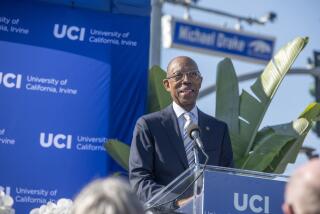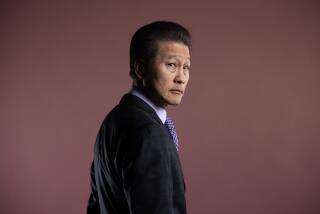CU Bancorp Replaces Its President
- Share via
John J. Keating led CU Bancorp to exceptional growth during the 1980s, making it the largest commercial bank based in the San Fernando Valley. But that growth abruptly stopped in the 1990s, which has now led to Keating’s abrupt exit.
Keating, 47, resigned last week as president and chief executive of both Encino-based CU and its principal unit, California United Bank. He remains a consultant and director, however.
CU’s board replaced him with Stephen G. Carpenter, 52, a former executive of Security Pacific Corp. who said he was unable to find a satisfactory role at BankAmerica Corp. after BankAmerica bought Security Pacific two months ago. At Security Pacific, Carpenter specialized in the “middle market” segment of lending to small- and mid-sized businesses--which is CU’s niche.
Keating did not respond to interview requests. But CU’s chairman, Melvin Gagerman, said “it was mutual” between Keating and the board that Keating should step down.
“When you have a bad year, everybody gets a little concerned,” Gagerman said. “But it wasn’t a one-year issue. We’ve had a great run, and now we felt we needed some new ideas to take us to the next level.”
Another CU director, Encino accountant Paul W. Glass, said “everyone thinks highly of John Keating. But we felt the future would be better served with a banker with the background of Mr. Carpenter.”
Keating, a forthright New York native, had been the only president in the 10-year history of CU, which originally was called Lincoln National Bank. The bank adopted its current name in 1990 because of ongoing public confusion between Keating’s bank and Lincoln Savings, the failed thrift run by Charles H. Keating Jr., who has since been convicted of California securities fraud charges.
John Keating also was one of CU’s original investors, with a $100,000 stake, and he quickly and aggressively expanded the bank’s size. Within five years it became the second-largest bank (by assets) based in the Valley, and it assumed the top post in January after regulators shut down Indpendence Bank in Encino.
CU, whose assets totaled $523 million as of March 31, also routinely earned a return on average assets--a measure of how profitably it employs its assets--of 1% or more, an excellent showing.
But that all ended in 1991. Battered by the economic recession and the sour real estate market, CU was forced to add $14 million to its loan-loss reserves, which led to a $3.6-million net loss that year, the company’s first annual deficit.
The troubles continued in this year’s first quarter, as CU’s profit tumbled 40% from a year earlier, to $595,069, and Keating predicted more problems for the bank’s commercial-loan portfolio.
The bank’s stock has slumped in kind. After trading as high as $10.25 a share during the past year, the stock closed Monday at $5 a share in national over-the-counter trading.
Carpenter has experience rebuilding troubled loan portfolios, but CU’s aspirations go well beyond strengthening its current book of business, Gagerman said. “We want to take a much larger market share,” he said. “We want to make a very dramatic impression on the middle-market.”
Keating’s departure, meanwhile, came relatively cheaply for CU even though ousting executives can often be costly for companies if the executives have lengthy terms remaining on their contracts.
According to CU’s proxy statement for 1990--the most recent year that’s publicly available--Keating’s five-year contract expires in December. The pact provided him with a base annual salary of $144,000 and bonuses based on CU’s profitability. (Those bonuses lifted Keating’s compensation to $398,636 in 1990, according to the proxy.)
So, CU only had to pay about the last six months of Keating’s contract, Gagerman confirmed. That would amount to about $72,000 based on the 1990 salary, although Gagerman said Keating’s 1991 salary had been raised somewhat from the prior year.
More to Read
Inside the business of entertainment
The Wide Shot brings you news, analysis and insights on everything from streaming wars to production — and what it all means for the future.
You may occasionally receive promotional content from the Los Angeles Times.











